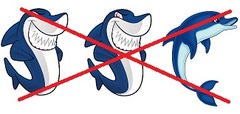Shark/dolphin congo line!
A group of sharks and dolphins decide to start a congo line at a wedding...

The only condition is that in any group of three in a row, the sharks can't outnumber the dolphins, lest the dolphin succumb to a terrible fate!

If they follow this rule, then how many ways can a "ten sea creature congo line" be formed, assuming there is a dolphin at the front and one at the end of the line?
Image credit: https://www.pinterest.com http://www.istockphoto.com/
The answer is 28.
This section requires Javascript.
You are seeing this because something didn't load right. We suggest you, (a) try
refreshing the page, (b) enabling javascript if it is disabled on your browser and,
finally, (c)
loading the
non-javascript version of this page
. We're sorry about the hassle.
This is a solution in progress, but gives the general idea of my approach...
Every time a shark lines up, he needs to be surrounded by dolphins (and they can't be dolphins that any other shark is surrounded by), so the question is analogous to saying how many ways can a group of one dolphin, or a group of three "dolphin shark dolphin"...
Lets call N n the number of ways that n sea creatures can line up to follow all the rules.
Then the above statement can be described by the following recursion relation:
Clearly, N 0 = N 1 = N 2 = 1 .
And, for n > 2 ,
N n = N n − 1 + N n − 3
(This is because if we already have a solution for n − 1 or n − 3 , we can either add one dolphin to it, or one "dolphin shark dolphin" combination to it to arrive at another solution for n )
Using this relation:
N 1 0 = 2 8